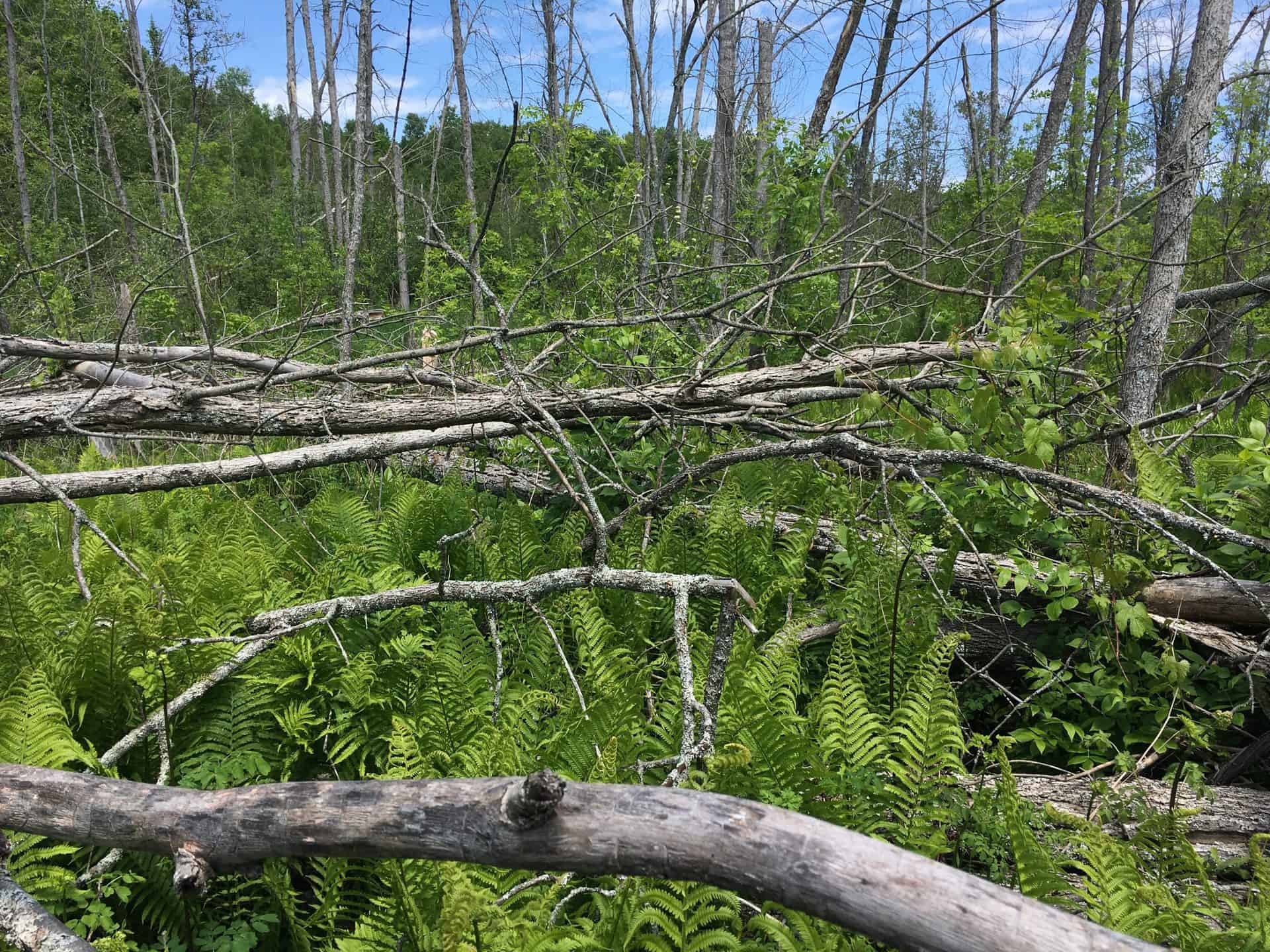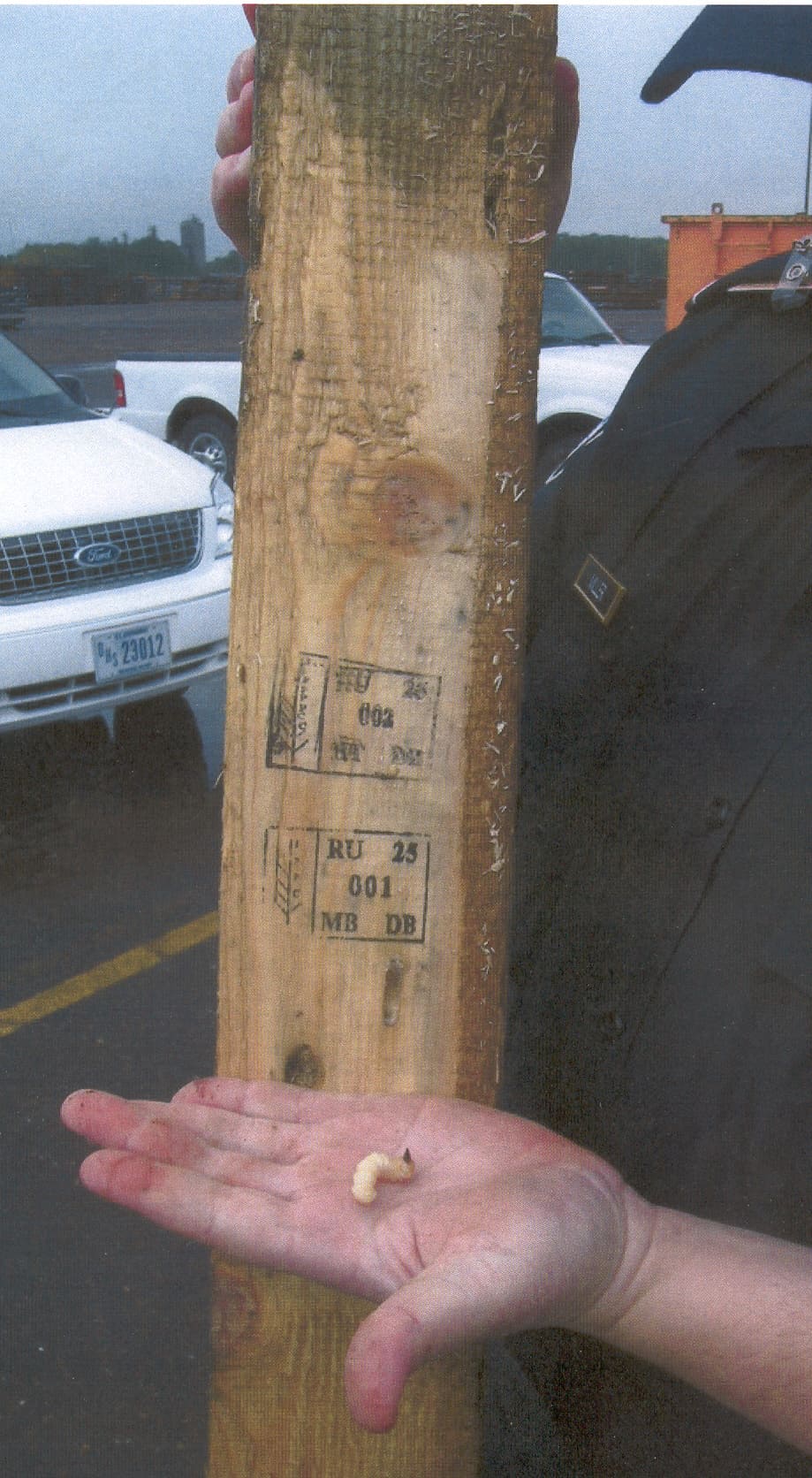 damage to forest caused by emerald ash borer; photo by Nate Siegert, USFS
damage to forest caused by emerald ash borer; photo by Nate Siegert, USFS wood packaging marked with ISPM#15 stamp with a live Cerambycid larva Oregon Dept of Agriculture
wood packaging marked with ISPM#15 stamp with a live Cerambycid larva Oregon Dept of AgricultureFor those of you who remember the Four Threats of the early 2000’s, they were fire and fuels, invasive species, loss of open space and unmanaged recreation. In years since, climate change has sucked much of the air out of the policy room. We still have fire and fuels (as exacerbated by climate change), loss of open space (perhaps 30 x30?) and travel management decisions, but perhaps overwhelmed by Covid visitation. The invasive species folks still labor on, pretty much unsung, although clearly dead trees, when live carbon-sucking ones are expected or modeled, do have an impact on climate change. Despite the importance of invasive species, somehow scientists and workers in that field seldom or never end up in the limelight.
I’d like to take this opportunity to highlight them and their work. I asked Faith Campbell to give us an update on what’s going on and how we can help.
*************************************************
Non-native insects and pathogens are threatening the ecosystem services provided by America’s forests. Already, the 15 most damaging of the circa 500 introduced pests threaten at least 40% of the total live forest biomass in the 48 conterminous states and have caused an additional (i.e., above background levels) tree mortality rate of 5.53 Terragrams of carbon per year (Fei et al. 2019).
To date, hardwood trees have suffered more damage from introduced pests than have conifers. The most damaging insect invader is the emerald ash borer, which has killed tens of millions of trees and threatens a unique ecosystem, black ash swamps. If it escapes eradication efforts, the Asian longhorned beetle would cause even more damage because of its wide host range. On the west coast, oak trees are under threat by the goldspotted oak borer and possibly the Mediterranean oak borer. Introduced diseases include chestnut blight, Dutch elm disease, oak wilt, and two diseases hammering beech – beech bark disease and the recently detected beech leaf disease. In the West, tanoaks and oaks are succumbing to sudden oak death; sycamores to the Fusarium disease vectored by invasive shot hole borers.
Overall, the highest elevation in biomass loss – as measured by Fei et al. (2019) using FIA plot data – was caused by emerald ash borer, Dutch elm disease, beech bark disease, and a major pest of a conifer, hemlock woolly adelgid. The spotted lanternfly https://www.dontmovefirewood.org/pest_pathogen/spotted-lanternfly-html/ might prove even more damaging to hardwood trees; its spread is extremely difficult to prevent. The threat to carbon sequestration and other ecosystem services is almost certain to increase due to continuing introductions of additional pests. The rising impact of pests, combined with more frequent and severe fires and other forest disturbances, are likely to negate efforts to improve forests’ carbon sequestration capacity (Fei et al. 2019; Quirion et al. 2021).
Insects that attack hardwoods – especially the highly damaging wood-borers – are usually introduced via crates, pallets, and other forms of wood packaging accompanying imports. The United States regulates incoming wood packaging according to a standard agreed to by parties to the International Plant Protection Convention (IPPC). How effective is this approach in preventing such introductions? Studies based on decade-old data have found that 1) 75% of containers used in maritime shipments contain wood packaging (Meissner et al. 2009); and 2) one out of each thousand incoming shipments containing wood packaging was infested (Haack et al. 2014). This sounds like a low risk. But in 2021, the ports of Los Angeles and Long Beach alone received more than 14 million TEUs (a standardized measurement of shipping containers – twenty foot equivalent). Major ports on the East coast – New York-New Jersey, Savannah, and Charleston – received another 7.9 million [data from the ports’ websites]. Calculating based on the Meissner and Haack findings results in an estimate that 15,700 insect-infested containers arrived on U.S. shores last year.
How should USDA reduce this risk? First, the lead agency, the Animal and Plant Health Inspection Service (APHIS) should boost its enforcement of the existing rules – which have been in place since 2006. APHIS should penalize importers whose shipments don’t comply with the standard’s requirements.
Second, APHIS should clarify the current “approach rate” of pests in wood packaging and take action – unilaterally or in collaboration with IPPC partners – to close loopholes. APHIS has taken one step on this road: it has finally agreed to allow Bob Haack and colleagues to update the earlier study, using data through 2021. We should see the results soon.
Will APHIS act then?
What about detecting pests when they first arrive? APHIS and the USFS manage significant detection surveys. Still, most detections result from citizens noting damage to their trees – usually a decade or more after the introduction occurred. APHIS and the state departments of agriculture are strengthening their collaboration with citizen science projects. However, if the agency takes no action in response to a reported pest, citizens will give up in frustration.
What You Can Do
Educate your colleagues about the impact of invasive forest pests. Educate your member of Congress and senators about the importance of pressing APHIS to use its enforcement powers to deter violations of regulations governing wood packaging accompanying imports.
Faith Campbell is president of the Center for Invasive Species Prevention. She has spent 30 years advocating for more effective policies to prevent introduction and spread of tree-killing insects and pathogens. She posts blogs on these issues at www.cisp.us
SOURCES
Fei, S., R.S. Morin, C.M. Oswalt, and A.M. 2019. Biomass losses resulting from insect and disease invasions in United States forests. Proc. Nat. Acad. Sci. USA. 116(35). 17371-17376. doi:10.1073/pnas.1820601116
Haack R.A., Britton K.O., Brockerhoff E.G., Cavey J.F., Garrett L.J., et al. 2014 Effectiveness of the International Phytosanitary Standard ISPM No. 15 on Reducing Wood Borer Infestation Rates in Wood Packaging Material Entering the United States. PLoS ONE 9(5): e96611. doi:10.1371/journal.pone.0096611
Meissner, H., A. Lemay, C. Bertone, K. Schwartzburg, L. Ferguson, and L. Newton. 2009. EVALUATION OF PATHWAYS FOR EXOTIC PLANT PEST MOVEMENT INTO AND WITHIN THE GREATER CARIBBEAN REGION. Caribbean Invasive Species Working Group (CISWG) and Plant Epidemiology and Risk Analysis Laboratory (PERAL) / CPHST. June 4, 2009
Quirion BR, Domke GM, Walters BF, Lovett GM, Fargione JE, Greenwood L, Serbesoff-King K, Randall JM & Fei S (2021) P&P Disturbances Correlate With Reduced Carbon Sequestration in Forests of the Contiguous US. Front. For. Glob. Change 4:716582. [Volume 4 | Article 716582] doi: 10.3389/ffgc.2021.716582
For an extensive overview of invasive species’ impacts in American forests, see Poland, T.M., Patel-Weynand, T., Finch, D., Miniat, C. F., and Lopez, V. (Eds) (2019), Invasive Species in Forests and Grasslands of the United States: A Comprehensive Science Synthesis for the United States Forest Sector. Springer Verlag. Available for download at no cost at https://www.fs.usda.gov/treesearch/pubs/61982
A study focused on the West: Barrett, T.M. and G.C. Robertson, Editors. 2021. Disturbance and Sustainability in Forests of the Western United States. USDA Forest Service Pacific Northwest Research Station. General Technical Report PNW-GTR-992. March 2021